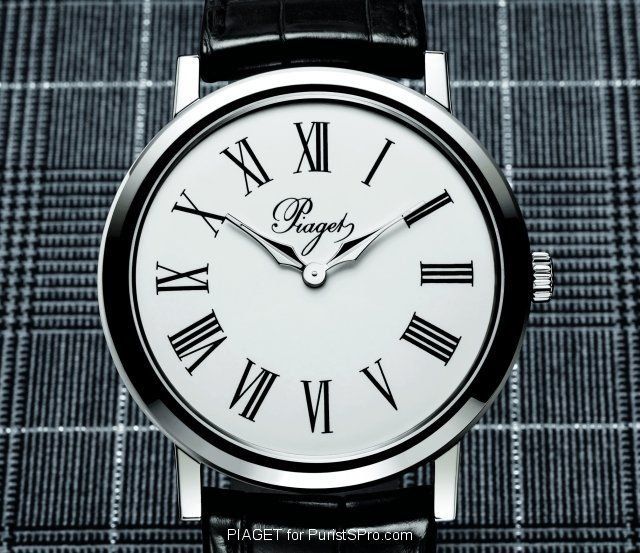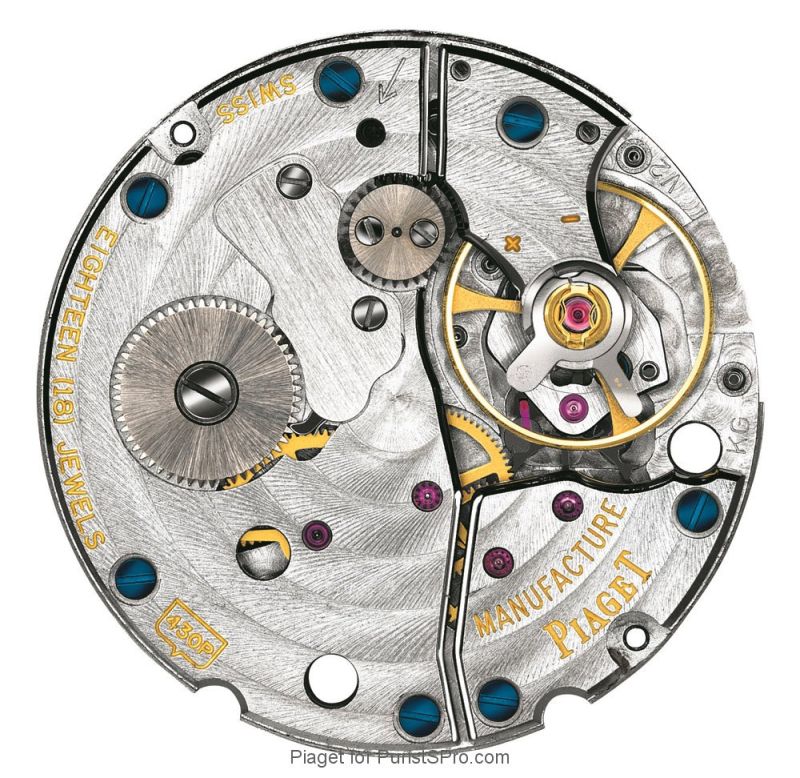
dxboon
[Elite User]
12450

PIAGET Altiplano Saga: Part 3 – For Your Eyes Only – Enamel Altiplanos
The expert craftsmen at Piaget do not leave us wanting when it comes to the quality of their enamel-work. While Piaget's artisans have mastered a plethora of horological arts, their facility in the labor-intensive techniques of traditional enamel-work deserve more than a passing glance. Feast your eyes on this:

The elegance of this particular ultra-thin watch, housing Manufacture Piaget's caliber 9P2, cannot be denied. Look at the deceptively simple, but perfectly finished case; luscious enamel dial; slender and ideally-proportioned Romans; unique, sculpted hands; and the Piaget logo written in that gorgeous script.

The Altiplano collection has proven an ideal palette for many of the watchmaker's decorative techniques, so it is no surprise that enamel-work is showcased so successfully by this particular family of timepieces. First, however, let us understand the basics of enameling. As our esteemed Piaget Moderator, MTF, has stated, enameling is as much an art as it is a science. An excerpt from a previous article by MTF on the subject:
"Enamel is simply glass which is ground to a powder before being fired and fused on a metal base. Suitable metals for enamelling include gold, silver, copper, aluminium, and steel. The ground glass is a combination of silica and soda ash with added metal oxides to give colour.
Enamelling is the process of fusing layers of ground glass onto metal using a kiln or torch. Firings can take from 30 seconds to several minutes, with the kiln heated between 650°C and 1000°C, depending on the techniques and materials used. Industrial, or liquid enamels are enamel frits that are ground very finely and mixed with other components to make a liquid suspension. This is applied to a metal surface with a spray gun, a brush, or by dipping.
Enamel powder is often applied as a paste, and may be transparent or opaque when fired; vitreous enamel can be applied to most metals. It has many excellent properties: it is smooth, hard, chemically resistant, durable, can assume brilliant, long-lasting colours, and cannot burn. Its disadvantage is a tendency to crack or shatter when the substrate is stressed or bent.
Colour in enamel is obtained by the addition of various minerals, often metal oxides of cobalt, praseodymium, iron, or neodymium. The last creates delicate shades ranging from pure violet through wine-red and warm grey. Enamel can be either transparent, opaque or opalescent (translucent), which is a variety that gains a milky opacity the longer it is fired. Different enamel colours cannot be mixed to make a new colour, like paint. This produces tiny specks of both colours; although the eye can be tricked by grinding colours together to an extremely fine, flour-like, powder.
It seems to me that the process is more of an Art rather than a Science because pyrometer readings vary widely from kiln to kiln. Thus no precise firing temperatures are “universal". Enamelling on silver is very different from enamelling on copper; what is high firing on silver is probably a low firing for copper. Enamellers share information as hints about where to look for specific effects and enamel behaviour, more than Standard Operating Procedures."
Grand feu enamel
The Altiplano family has some beautiful examples of enameling technique. My favorite, and I suspect the favorite of many PuristS, is pure or grand feu enamel. Grand feu enamel is characterized by the very high temperatures at which it is fired. It reaches its melting point between 1508°F and 1562°F (820°C and 850°C). The laborious preparation of the enamel, even before heat is applied, involves the grinding in a mortar of raw, coarse enamel into a much finer substance. This flour-like powder is rinsed, and re-rinsed until clean, and then stocked in distilled water. This painstaking work by Piaget ensures that the end result is a pure enamel with an increased ability to withstand the degrading effects that time has on all vitreous arts.

Above, an example of grand feu enamel.
Champlevé flinqué enameling
The two Altiplanos that follow exhibit flinqué enamel dials. Piaget creates these expressive beauties by engraving the dials with a basket-weave guillochage pattern known as "panier." The engraving is then covered by a translucent layer of enamel. This combination of decorative techniques creates a dial of immense depth, and a trompe l'oeil effect of swirling movement. Manufacture Piaget has previously shown itself to be masterful at achieving lustrous, intense colors, and these watches further drive home that point. I particularly love the stormy green dial on the men's version of this watch, but for a party would most certainly reach for the ladies' model in purple with diamond-set bezel.

Ref. G0A33082, Men's 38mm Altiplano with flinqué enamel dial in a sophisticated, understated, and masculine gray-green.

Ref. G0A33083, Ladies' 34mm Altiplano with flinqué enamel dial in a luscious purple with gem-set bezel. The illusion of movement created by the enameling technique is almost holographic.
Both men's and ladies' versions, limited editions of 50 pieces each, house the hand-wound Manufacture Piaget Caliber 430P in a 18K white gold case.
Miniature enamel painting
The creation of high-quality miniature enamel painting can be a challenging adventure for even the most seasoned enameler. It's a demanding practice that calls for patience and extensive knowledge of various artistic techniques. Enamel painting starts when a layer of enamel is baked onto a gold plate. This layer of enamel will serve as the base for the decoration to come. The chosen motif will then be painted by hand on this enamel base. The delicate nature of this work necessitates that the finely powdered enamel be mixed with natural oil essences in order to ease their application onto the project's base layer. The painting is applied layer by painstaking layer, with visits to the kiln for firing between each one. Each successive firing intensifies the color of the enamels, so proper pre-planning on the part of the enameler is needed to ensure that the correct hue is affixed at that very last firing. Once the painting is finished, a final layer of transparent enamel called "flux" is applied to protect the masterpiece and add that special sheen that elevates the end result to even more radiant heights. This process is known as the "Geneva" technique.
Piaget's strengths in a variety of decorative arts, like enameling, pair perfectly with their mastery of haute horlogerie and haute joaillerie. Their stable of artists, working together, create miniature marvels at every turn. Some of my favorite artistic enamel pieces are found in the Altiplano family, specifically those with an orchid motif -- each one a piece unique displaying a variety of decorative techniques. Piaget has set before us a garden of delights...

Ref. G0A33240 18K white gold case set with 78 brilliant-cut diamonds (approx 0.7 ct)
Miniature enamel dial, Cattleya orchid painting, silvered baton hands

Ref. G0A33241 18K white gold case set with 78 brilliant-cut diamonds (approx 0.7 ct)
Miniature enamel dial, Doritaenopsis-Kenneth Schubert orchid painting, silvered baton hands

Ref. G0A33242 18K white gold case set with 78 brilliant-cut diamonds (approx 0.7 ct)
Miniature enamel dial, Doritaenopsis-Malibu Easter orchid painting, silvered baton hands

Ref. G0A33243 18K white gold case set with 78 brilliant-cut diamonds (approx 0.7 ct)
Miniature enamel dial, Dendrobium-Pale Doreen orchid painting, silvered baton hands
Perfect press packet photos are nice, but the real warmth, precision, and liveliness of the various enamel techniques used in these orchid-motif Altiplanos TRULY comes through in the live photos below, courtesy of MTF.

Ref. G0A34242, 18K white gold with diamond bezel "Profusion Laeliocattleya" Altiplano.

Ref. G0A34241 18K white gold diamond-set bezel "Golden of Tainan Brassolaeliocattleya" Altiplano.
These poetic timepieces are graced with orchids painted in the miniature enameling technique. It takes Piaget artisans a month to finish these dials and incorporate the flinqué enameling, as well. The flinqué creates a dazzling backdrop for the painted enamel flowers, but frankly these guilloché dials covered in a transparent tinted enamel would be remarkable works of art even without the painted orchids. Naturally, like all great Piaget watches, the engine powering these Altiplanos is a beauty -- Manufacture Piaget caliber 430P, an ultra-thin hand-wound movement.

Manufacture Piaget caliber 430P
So, why enamel? Why does it capture our imagination; our hearts? Piaget has certainly shown us, with the watches above, its many beautiful applications. For me, fine enamel-work is appealing because it has a life, an almost mystical warmth that is rapturous. Piaget's enameling techniques display the inner fire evident in all great vitreous arts -- be it mouth-blown traditional art glass from the Venetian isle of Murano (not the horrid tourist junk in gaudy colors, but the real thing, classically prepared) or the magnificently complex stained glass windows of York Minster. We are drawn to enamel, because in its finest forms, our eyes perceive it as light and warmth solidified. With its enamel-work wristwatches, Piaget allows us to take these little masterworks with us wherever we go. I can't see anything wrong with that.
I must take this moment to acknowledge the reference material from MTF and Piaget that informed this post. The Piaget Altiplano collection holds a vast sea of riches when it comes to decorative, jewel-setting, and horological techniques. We will continue to explore these offerings in upcoming articles, so be sure to check the forum regularly!
The Altiplano will return...
Cheers,
Daos
PIAGET Altiplano Saga series:
Part 1 - The World is Not Thin Enough – Manual 9P movement:
piaget.watchprosite.com
Part 2 – GoldenEye – Automatic 12P movement:
piaget.watchprosite.com
Part 3 – For Your Eyes Only – Enamel Altiplanos:
piaget.watchprosite.com
Part 4 – From La Côte-aux-Fées, With Love – Diamonds Are Forever (Exceptional Altiplanos):
piaget.watchprosite.com
Part 5 – The Living Daylights – Skeleton Altiplanos:
piaget.watchprosite.com
Part 6 – Never Say Never Thin Again – Automatic 1200P/1208P movements
piaget.watchprosite.com
Part 7 – Quantum of Solace – Special Altiplanos and Updates
piaget.watchprosite.com
This message has been edited by MTF on 2013-09-16 05:35:18

PIAGET Altiplano Saga: Part 3 – For Your Eyes Only – Enamel Altiplanos

Sign me up!

LOL!

Great review Daos

I think the watch is simply breathtaking!

one of

I find the best enamel dials to be utterly fascinating!

Beautiful photos and writeup

Thank Piaget...

oh my

Released in 2007 as a Boutique Only edition of 50 pieces!

Oooops.. shows how much of a

No worries, Arthur!

Great post Daos!

Orchids make a great subject for these pieces...

Thanks for another great article Daos...

Definitely take a look in person, Dino!

Thanks Daos. Piaget certainly deserves a second look and your post is a reminder of that.

Piaget continue to impress me.

1957 Enamel Altiplano re-edition

If this piece only makes the list at #2...

You're welcome!

Enamel Altiplanos

